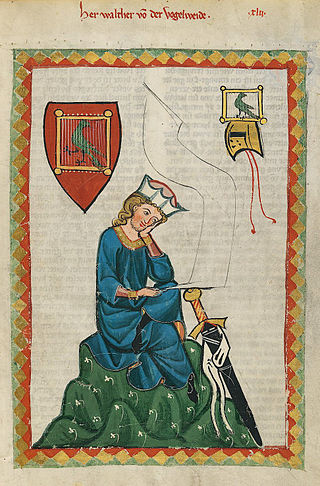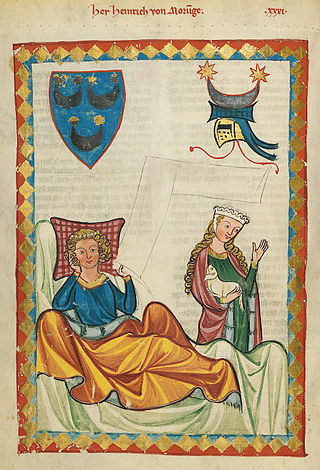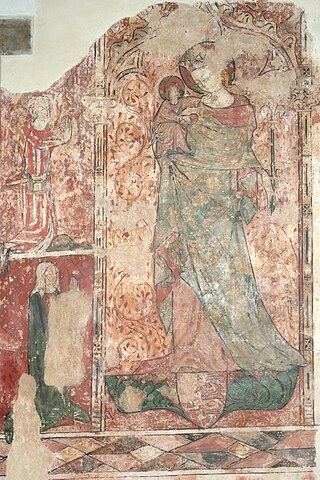Lyrics are words that make up a song, usually consisting of verses and choruses. The writer of lyrics is a lyricist. The words to an extended musical composition such as an opera are, however, usually known as a "libretto" and their writer, as a "librettist". The meaning of lyrics can either be explicit or implicit. Some lyrics are abstract, almost unintelligible, and, in such cases, their explication emphasizes form, articulation, meter, and symmetry of expression. Rappers can also create lyrics that are meant to be spoken rhythmically rather than sung.

Modern lyric poetry is a formal type of poetry which expresses personal emotions or feelings, typically spoken in the first person.

Minnesang was a tradition of lyric- and song-writing in Germany and Austria that flourished in the Middle High German period. This period of medieval German literature began in the 12th century and continued into the 14th. People who wrote and performed Minnesang were known as Minnesänger, and a single song was called a Minnelied.

"Sumer is icumen in" is the incipit of a medieval English round or rota of the mid-13th century; it is also known variously as the Summer Canon and the Cuckoo Song.

Ancrene Wisse is an anonymous monastic rule for female anchoresses written in the early 13th century.
Middle English lyric a genre of English literature, is characterized by its brevity and emotional expression. Conventionally, the lyric expresses "a moment," usually spoken or performed in the first person. Although some lyrics have narratives, the plots are usually simple to emphasize an occasional, common experience. Even though lyrics appear individual and personal, they are not "original"; instead, lyrics express a common state of mind. Those states of mind are wide in range. Some deal with religious topics pertaining to Jesus or the Virgin Mary, focusing on Christ's sacrifice and salvation, or Mary's roles as a mother and intercessor. Other religious topics focus on Adam and the Fall, or the necessity of faith. Others are secular, focusing on ale, women, and the simple joys of life. Some are sarcastic, satiric, humorous, or even crude.

Heinrich von Morungen or Henry of Morungen was a German Minnesinger.
South English legendaries are compilations of versified saints' lives written in southern dialects of Middle English from the late 13th to 15th centuries. At least fifty of these manuscripts survive, preserving nearly three hundred hagiographic works.
When The Nightingale Sings is a Middle English poem, author unknown, recorded in the British Library's Harley 2253 manuscript, verse 25. It is a love poem, extolling the beauty and lost love of an unknown maiden.

The Kildare Poems or Kildare Lyrics are a group of sixteen poems written in an Irish dialect of Middle English and dated to the mid-14th century. Together with a second, shorter set of poems in the so-called Loscombe Manuscript, they constitute the first and most important linguistic document of the early development of Irish English in the centuries after the Anglo-Norman invasion of Ireland. The sixteen poems contain both religious and satirical contents. They are preserved in a single manuscript, where they are scattered between a number of Latin and Old French texts. The conventional modern designation "Kildare poems" refers both to the town of Kildare in Ireland, which has been proposed as their likely place of origin, and to the name of the author of at least one of the poems, who calls himself "Michael (of) Kildare". The poems have been edited by W. Heuser (1904) and A. Lucas (1995).

"Lullay, mine liking" is a Middle English lyric poem or carol of the 15th century which frames a narrative describing an encounter of the Nativity with a song sung by the Virgin Mary to the infant Christ. The refrain is an early example of an English lullaby; the term "lullaby" is thought to originate with the "lu lu" or "la la" sound made by mothers or nurses to calm children, and "by" or "bye bye", another lulling sound.

The Harley Lyrics is the usual name for a collection of lyrics in Middle English, Anglo Norman, and Latin found in Harley MS 2253, a manuscript dated ca. 1340 in the British Library's Harleian Collection. The lyrics contain "both religious and secular material, in prose and verse and in a wide variety of genres." The manuscript is written in three recognisable hands: scribe A, scribe B or the Ludlow scribe, and scribe C.
The Proverbs of Hendyng is a poem from around the second half of the thirteenth century in which one Hendyng, son of Marcolf, utters a series of proverbial stanzas. It stands in a tradition of Middle-English proverbial poetry also attested by The Proverbs of Alfred; the two texts include some proverbs in common. The rhyme scheme is AABCCB.
Foweles in the frith is a short, five-line Middle English poem. It is found in a manuscript from the thirteenth century containing mostly legal writings, and is accompanied by a musical score for two voices.
Thorlac Francis Samuel Turville-Petre is an English philologist who is Professor Emeritus and former head of the School of English at the University of Nottingham. He specializes in the study of Middle English literature.
"Maiden in the mor lay" or "The Maid of the Moor" is a Middle English lyric of the early 14th century, set to a melody which is now lost. The literary historian Richard L. Greene called it "one of the most haunting lyrics of all the Middle Ages", and Edith Sitwell thought it "a miracle of poetry". It is a notoriously enigmatic poem, perhaps devotional, perhaps secular, which depicts a maiden in the wilderness who lives on flowers and spring-water. Critics are divided in their interpretation of her: she may be the Virgin Mary, Mary Magdalene, a water-sprite, or an ordinary human girl. The 14th-century bishop Richard de Ledrede's dissatisfaction with this song led to an alternative lyric for it being written, a Latin religious poem, Peperit virgo.

"Alysoun" or "Alison", also known as "Bytuene Mersh ant Averil", is a late-13th or early-14th century poem in Middle English dealing with the themes of love and springtime through images familiar from other medieval poems. It forms part of the collection known as the Harley Lyrics, and exemplifies its best qualities. There may once have been music for this poem, but if so it no longer survives. "Alysoun" was included in The Oxford Book of English Verse, The Norton Anthology of English Literature, and The Longman Anthology of British Literature. It has been called one of the best lyrics in the language.
"Lenten ys come with love to toune", also known as "Spring", is an anonymous late-13th or early-14th century Middle English lyric poem which describes the burgeoning of nature as spring arrives, and contrasts it with the sexual frustration of the poet. It forms part of the collection known as the Harley Lyrics. Possibly the most famous of the Middle English lyrics, it has been called one of the best lyrics in the language, and "a lover's description of spring, richer and more fragrant in detail than any other of its period." No original music for this poem survives, but it has been set to music by Benjamin Britten, Alan Rawsthorne and others. It was included in The Oxford Book of English Verse.
"Ichot a burde in boure bryht", sometimes titled, after its burden, "Blow, Northerne Wynd", is an anonymous late-13th or early-14th century Middle English lyric poem. The text forms part of the collection known as the Harley Lyrics.

"A wayle whyt ase whalles bon", also titled after the opening of its refrain "Ich wolde ich were a threstelcok", is an anonymous late-13th or early-14th century Middle English lyric poem. The text forms part of the collection known as the Harley Lyrics.









